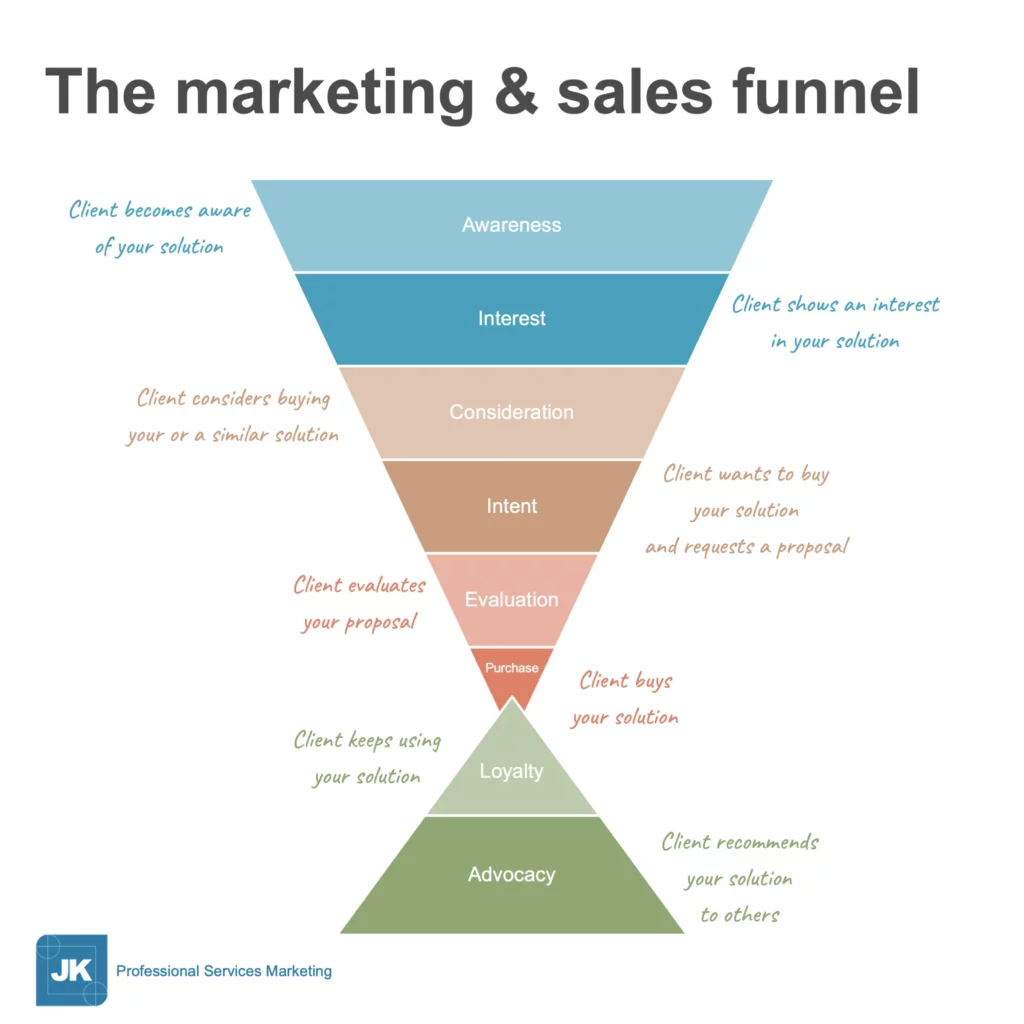Stop using the marketing & sales funnel with non-marketers.
Have you ever tried to explain marketing or sales using the marketing & sales funnel? Maybe to a subject matter expert from your organization? Or a board member?
And did that help you (or them) at all?
Don’t get me wrong. I think the marketing & sales funnel is a great tool. I’m just not a big fan of using it in discussions with non-marketing colleagues.
I’ll tell you why in a minute, but let’s have a look at that funnel and all of its stages first:

Looks good, right!? And… it is.
If you can find a way to trace your prospective clients through the funnel and tailor all your marketing and sales efforts to their needs, by all means do.
I just think you shouldn’t use the model in discussions with non-marketers. Especially in a professional service firm.
Here’s are 3 reasons why:
- Name – From a marketer’s perspective calling it ‘the marketing & sales funnel’ makes perfect sense. It helps you decide which stages to focus your time and energy on.
But, calling it ‘the marketing & sales funnel’ also implies that marketing and sales are in the lead. This of course isn’t true. Marketing and sales are trying to influence the client – to the best of their ability, but the client is still very much in control.
That’s why I prefer the buyer (or buying) journey. As it puts the focus on the client. - Shape – The marketing and sales funnel is a theoretical model, shaped as a funnel. Wide at the top, narrow at the bottom. Which implies that if little comes out at the bottom, you should put more in at the top. But, that doesn’t hold up.
Making more organizations aware of your solution will not automatically result in more of them actually buying these solutions. In professional services marketing the funnel gets narrow very quickly. As most organizations that could buy from you, are not in market at all. So, chances of them showing an interest in your solutions are slim. Let alone consider buying from you. - Traceability – The marketing and sales funnel consists of 6 consecutive stages. Plus 2 extra stages, after a client purchased and actually used your solution. That’s quite the number of stages.
All of these stages may give you a sense of control. Just like the labels you can put on a prospective client for each phase. In reality however, a lot of what happens on the client side remains a black box.
Try to track as much as you can, but be honest about it and don’t use too many labels. In professional services marketing most of the deals you’re after are very specific anyway. And thus take a tailored approach.
When talking to non-marketers, I prefer the buyer journey. Collaboratively decide on the qualifications you’ll use for prospective clients in each stage of their journey. And determine the actions you’ll take.
Hope this helps!
Thank you for reading MBD Boost #008, sent to marketers and business developers on April 23, 2024.
Are you an MBD Spark subscriber?

Bi-weekly tips & thoughts on marketing & business development.
For everyone involved or interested in bringing professional services to market.
Subscribe today!
